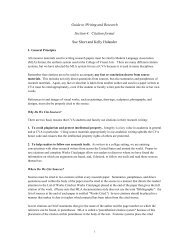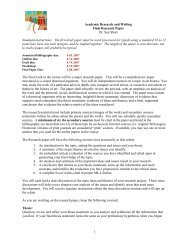Woman with a Fan: Paul Gauguin's Heavenly Vairaumati-a Parable ...
Woman with a Fan: Paul Gauguin's Heavenly Vairaumati-a Parable ...
Woman with a Fan: Paul Gauguin's Heavenly Vairaumati-a Parable ...
You also want an ePaper? Increase the reach of your titles
YUMPU automatically turns print PDFs into web optimized ePapers that Google loves.
4 (Gatigin, Te aa no Arcois (Thw Seed o/<br />
dhe ArioiN,), 1892, oil on burlap, 361/4 X<br />
28KY in. Ilihe Museum of Modern Art,<br />
New York, The William S. Paley<br />
Co'llction, SPC14.1990 (artwork in the<br />
ptiblic domain: digital image © The<br />
Museum of* Modern Art/licensed by<br />
Sc(ala/Art Resonrcc, NY)<br />
in(dcrtook his own account of the Polynesian pantheon of<br />
gods and the related myth of creation, the illustrated Ancien<br />
cu/le ma/ltoir (Ancient Maari Cu/I). This text, which includes<br />
passagcs copied verbatim from Moerenhout, introduces the<br />
themes aronmd which the artist probed the mysteries of death<br />
and regeneration that permeate his work throughout the last<br />
decadc of his life. Gauguin emphasized pointed parallels <strong>with</strong><br />
Ihe Bible. The exegesis on the "Eternity of Matter" recounts<br />
tie dialogue where Tefatou, god of the earth, mandates the<br />
death of all living things, which the divine Hina counters to<br />
secure their rebirth. 5 The instrument of this regeneration<br />
was Vaiiamniati, the beautiful mortal chosen by the god Oro<br />
to procreate a new race to replenish the world after the death<br />
ordained by Tefitou. After their son was conceived, Oro,<br />
tramisfOtried into a column of fire, rose to the heavens. On<br />
licr death, lie "likewise had Vairatimati rise, to take her place<br />
amnong the t)eities., 5 5 ( <strong>Gauguin's</strong> adaptation of this myth was<br />
stimuilated bv his fascination <strong>with</strong> the cult dedicated to Oro,<br />
WOM1AN A WIT1 A FAN: PAU I . G At (IT IN'S H EAVENLY \.A IRA UNA'It. 559<br />
the Arioi Society. 56 Consecrated to free love, this sect celebrated<br />
exuberant sexual rites and practiced infanticide until<br />
the society was eradicated by the combined forces of the<br />
missionaries and colonial authorities in the nineteenth century.<br />
Gauguin considered the amorous epic "one of the most<br />
important spiritual treasures that I had come to Tahiti in<br />
search of."' 57<br />
The myth inspired the first two of <strong>Gauguin's</strong> canvases<br />
based on Tahitian legends. He sketched <strong>Vairaumati</strong> Tei Oa<br />
(<strong>Vairaumati</strong> Is Her Name) in a letter to <strong>Paul</strong> S6rusier in March<br />
1892.:, She faces to the left, sitting at an angle on a typical<br />
floral cotton cloth that covers a slope of raised ground. She<br />
holds a cigarette in her left hand, her right hand placed to<br />
her side. Her pose is similar in the second painting of that<br />
year, Te aa no Areois (The Seed of the Ariois) (Fig. 4), where<br />
<strong>Vairaumati</strong> proffers a sprouting seed."M This symbol of fertility<br />
accords <strong>with</strong> her role as the mother of Oro's son, whose<br />
birth inspired the founding of the Arioi Society.s But it





